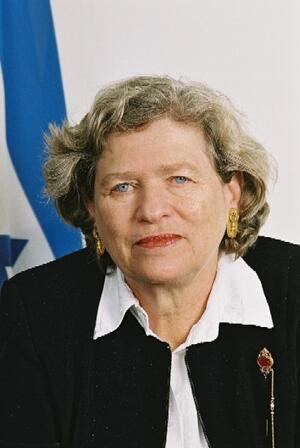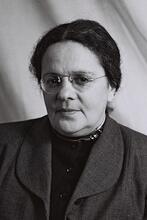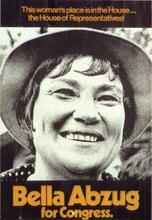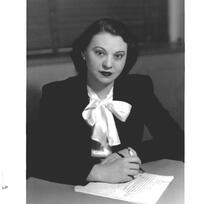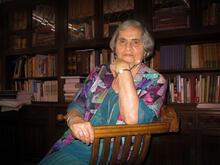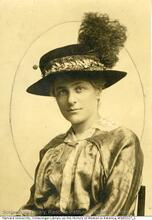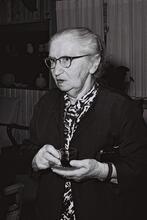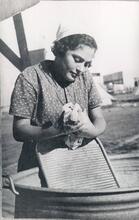Elisheva Barak-Ussoskin
Vice-President of the Israel National Labor Court Elisheva Barak-Ussoskin, date unknown.
Photo from the Judiciary of Israel. From Wikimedia Commons.
After earning her law degree in 1977, Elisheva Barak-Ussoskin quickly advanced through several positions before becoming a judge in the National Labor Court of Israel in 1995. The decisions of Judge Barak-Ussoskin, who is known for her extraordinary patience and excellent judicial spirit, are outstanding for their innovative character, thoroughness, well-argued and scholarly reasoning based on national as well as international and theoretical experience, and for the stress they lay on human rights in the sphere of labor and employment. Her rulings had a critical influence on the development of labor law and labor relations in Israel.
Family and Education
Vice-President of the Israel National Labor Court since November 2000, Elisheva Josephina Barak-Ussoskin was born on October 13, 1936, in Bycgarest, Romania. Her father, Moissei Moshe Ussoskin (1899-1982), was born in Soroki, Russia. An accountant by profession, he served as director of the Joint Distribution Committee in six Balkan countries and later as director-general of Keren Hayesod, United Israel Appeal.
In 1940 Ussoskin was arrested in Bucharest. Upon his release, the family fled via Turkey and Lebanon to Jerusalem, where they settled in February 1941. His wife, Marrusia Miriam (née Griner, b. Odessa 1904–d. 1987), was also an accountant and managed a department store. Elisheva was their only child.
After completing her studies at the Hebrew University High School in 1954, Elisheva proceeded to the Hebrew University of Jerusalem, where she studied from 1956 to 1963. While her M.Sc. is in zoology, genetics, and chemistry, she also studied psychology for two years and at the same time took courses in education. During this period she served as research assistant in human genetics to Professor Elisabeth Goldsmith and was also a teaching assistant in genetics.
In September 1957 she married Aharon Barak (b. 1936), President of the Supreme Court beginning in 1995. They have four children: Avner Israel Shimon (b. 1963), Esther (b. 1965), Michal Osnat Dvora (b. 1968), and Tamar (b. 1970).
Beginning in 1973 Barak-Ussoskin studied law at the Hebrew University and received her LL.B. in 1977. From 1976 to 1978 she clerked for the president of the Supreme Court, Justice Joel Sussman, and in the office of the district attorney. From 1978 to 1987 she was legal assistant to successive presidents of the Supreme Court: Sussman, Moshe Landau, Yitzhak Kahan, and Meir Shamgar. In 1987 she was appointed registrar of the Regional Labor Court in Jerusalem and in 1990 became a judge both there and in the Beersheba Regional Labor Court. In 1995 she was promoted to judge in the National Labor Court, becoming vice-president in November 2000.
Actions in the Labor Court
Barak-Ussoskin was appointed to the Labor Court at a period of transition and change in the nature of the labor market in Israel: the power of unions was declining, and labor relations shifted from collective to individual, leaving the employee alone in the forefront of conflict with the employer. Furthermore, in areas where labor relations were still collective, the bargaining power of the unions was extremely reduced. Since legislation of labor laws cannot replace human negotiations or resolve day-to-day problems, labor courts have become an important player in employment and labor relations. For their part, they immediately responded to the challenge.
Barak-Ussoskin was one of the most prominent judges to play a central role in keeping the balance between the ever-stronger power of employers, on the one hand, and the weaker status of individual employees and unions on the other. By implementing general legal norms like good faith, applying norms of public law to private employers, and importing innovative international labor court decisions, while also using strong judicial sense, she succeeded in issuing innovative rulings that drew new border lines for labor and employment relations. Mainly, she rejected formalism as a judicial norm, replacing it with a more modern attitude of adopting substantial interpretation as a platform for judicial innovations.
In a precedent-setting ruling of 1996, Barak-Ussoskin defended the right of an employee to choose the identity of her employer according to her personal career plans, notwithstanding formal employment relationship definitions. At the same time, and especially because of her non-formalistic attitude, Barak-Ussoskin was very keen on employees’ good faith behavior and was very strict with those who tried to exploit this attitude. One 2002 decision dealt with a professional diver, defined as an independent worker, who claimed severance pay after being dismissed. A 2001 decision dealt with employees of the national broadcasting authority who demanded overtime hours, which they formally deserved but which in practice were not performed. In these decisions, she stressed that extreme bad faith behavior of employees will deprive them of their other employment rights.
In dealing with another growing branch of employment, Judge Barak-Ussoskin established the right of people working from home to have accidents there recognized as work accidents. As a result, the recognition of work accidents was extended to those incurred by workers in activities in which workers had to participate despite their non-official character, such as staff-consolidation days and “happy-days” organized by their workplace.
The right to equal opportunities was always Barak-Ussoskin’s special concern. In a ground-breaking decision (1997) she granted high damages to a woman who applied for a position as sales agent and during the interview was informed that the job was too difficult for a woman. After being rejected, the candidate applied to court, claiming that she had been discriminated against on the basis of gender, and won her case.
Barak-Ussoskin insisted on implementing the good faith norms both in individual and collective labor law. In the collective sphere she stressed the special fiduciary relations of all sides—the employers and employers’ organizations and unions that oblige them not only to behave honestly with each other but also to take into consideration the interests of the public. For instance, while still a district judge (1992), she ruled that the freedom to strike of employees of the Ministry of the Interior, who are also responsible for issuing passports, should be balanced against the right of citizens to free movement and travel abroad. At the same time, she defended the right of organized workers to organize, demonstrate ,and picket peacefully.
In the era of privatization, one of her more dramatic decisions concerned the claim of employees of a governmental enterprise transferred to a private employer to receive their collective agreement rights despite their resignation. In a minority decision in the national labor court, she ruled that the privatization should be interpreted as laying-off, which granted the employees the right to receive higher severance pay than that dictated by law. Her opinion was affirmed in the high court of justice, which confirmed the contention of the employees.
The decisions of Judge Barak-Ussoskin, who is known for her extraordinary patience and excellent judicial spirit, are outstanding for their innovative character, thoroughness, well-argued and scholarly reasoning based on national as well as international and theoretical experience, and for the stress they lay on human rights in the sphere of labor and employment. Her rulings had a critical influence on the development of labor law and labor relations in Israel.

